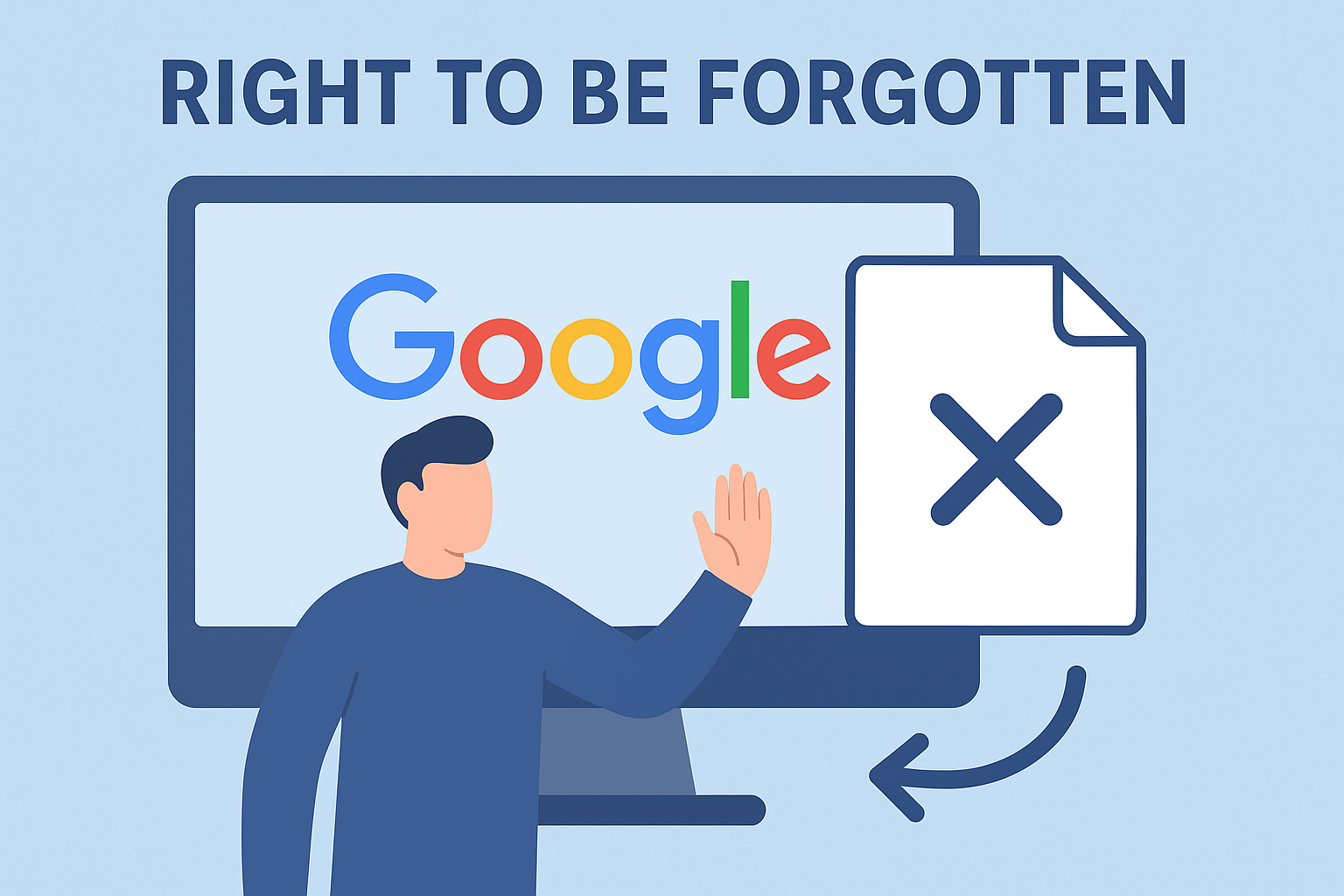Right to Be Forgotten: How the 2014 Google EU Ruling Impacts Reputation, SEO & Privacy (2025 Guide)

Short summary: In 2014 the European Court of Justice gave EU citizens the ability to ask search engines to delist certain search results that show outdated, irrelevant, or privacy-invasive personal information. Google created a formal request process, but removal is not deletion — and the ruling created new challenges for SEO, compliance, and reputation management. In this long guide I’ll explain how removal works, provide a step-by-step request workflow, share real-world tactics for remediation and suppression, and outline how you should build a long-term privacy + SEO strategy in 2025.
1. The Legal Background — What Happened in 2014?
The 2014 decision (commonly called the “Right to Be Forgotten”) came from the European Court of Justice, which interpreted EU privacy law to permit individuals to request delisting of search results that include their name when links are “inadequate, irrelevant or no longer relevant.” The key points from the ruling:
- It created an obligation for search providers to offer a removal mechanism and to evaluate requests.
- Search engines must balance privacy against public interest — there is no automatic, blanket delisting.
- Decisions vary by country and by content type (e.g., newspapers, public records, criminal records have higher public interest thresholds).
Since then, GDPR and subsequent court rulings refined scope and process, and Google’s procedures have evolved — but the central tension remains: privacy vs public information.
2. How Google’s Removal Process Works (Step-by-Step)
Google’s removal system is designed to be transparent but legally cautious. Below is a practical, step-by-step approach you or your client should expect and prepare for.
Step A — Prepare your case
Collect the exact URLs you want removed, screenshots, and documentation proving why the content is outdated, inaccurate, or a privacy breach. If you’re requesting removal for personal data, have ID ready for verification (Google will require identity confirmation for many requests).
Step B — Submit via Google’s removal form
Use Google’s official form (Search Console / Legal Removals portal). Provide concise, factual reasons and attach supporting documents. Make the narrative clear: explain why the content is no longer relevant and why public interest does not require continued visibility.
Step C — Google’s evaluation
Google reviews the request, weighing privacy concerns against public interest. This step may involve legal teams and can take weeks to months. Expect follow-ups requesting clarification.
Step D — Decision and notification
If approved, Google delists the URL from the relevant regional index (e.g., EU). Google usually notifies the webmaster that a URL was delisted, but not the identity of the requester. If denied, Google will explain the rationale and point to the public-interest reasoning.
Step E — Post-decision strategy
Whether approved or denied, take action: update your content strategy, pursue takedowns to hosts if necessary, or implement suppression SEO to push negative items down.
3. What a Delisting Actually Means (and Why It’s Limited)
It’s crucial to understand what delisting does & does not achieve:
- Does: Reduce discoverability on the specified Google regional index (e.g., google.fr, google.de) for queries including the person’s name.
- Does not: Remove the underlying content from the hosting site, prevent republication, or guarantee global invisibility.
- Implication: Attackers or publishers can republish content, or users outside the targeted region may still find the content. Therefore, delisting is one tool in a broader remediation strategy.
4. Real-world Case Studies (Short)
Case: Individual — Old criminal record
A private citizen with an entirely served sentence requested removal of a decade-old news link tied to a minor offense. Google approved removal in the EU after finding the news was no longer of public interest given the time elapsed and rehabilitation evidence. The individual combined removal with fresh positive content (professional profile, interviews) to rebuild branded search results.
Case: Small Business — Unfounded allegations
A local business faced malicious posts on a low-authority blog. Google denied full removal due to public interest claims, but the business worked with an SEO consultant to publish authoritative customer testimonials, press releases, and directory listings. Within 4 months, the negative link was demoted from page 1 to page 3 for branded search terms.
5. Reputation Strategy: Removal + Suppression (The Practical Playbook)
Removal alone rarely solves a reputation issue. The recommended three-pronged approach:
- Legal / removal attempts: Submit requests and, where necessary, pursue takedowns through hosts or courts.
- Technical remediation: Correct inaccurate information on your site, add timestamps, or legal notices where appropriate.
- SEO suppression: Create and optimize authoritative pages (LinkedIn, company site, high-quality blog posts, press coverage) to outrank negative content. Use targeted internal linking, schema markup, and outreach to earn quality backlinks for positive pages.
Practical SEO tactics that work
- Publish a sequence of authoritative pages with exact-match and related phrase optimization (long-tail keywords around your name + role).
- Use structured data (Person, Organization, Article) to help Google understand and prioritize new positive content.
- Earn backlinks from trusted domains (news sites, industry portals) to increase the ranking power of positive pages.
- Leverage Google Business Profile, Wikipedia (where appropriate), and professional directories for high-authority coverage.
6. What Webmasters Should Do When They Get a Delist Notification
Site owners who receive a notice from Google should:
- Audit the flagged content and evaluate the claim’s legitimacy.
- Preserve records — screenshots, timestamps, and correspondence — in case of legal disputes.
- Assess whether updating or adding context (corrections, editor’s notes) could mitigate harm while maintaining transparency.
- Seek legal advice for threats of defamation, privacy violations or spurious takedown requests.
7. The Future: AI, Global Privacy Trends & 2025 Considerations
By 2025 the privacy landscape and search have evolved: AI summarization (Search Generative Experience), cross-border privacy law updates, and platform-level moderation influence discoverability. Key things to know:
- AI summarization: Large language models can surface snippets that summarize content from multiple sources — even if individual links are delisted regionally. This raises new privacy considerations.
- Jurisdiction matters: National laws (beyond the EU) are expanding privacy rights. Removal outcomes will depend increasingly on local law and bilateral agreements.
- Proactive branding wins: The best long-term defense is proactive — own as much high-quality real estate as possible for your name or brand (sites you control, reputable profiles, press releases).
8. Step-by-Step Checklist: If You’re Considering a Removal
- Identify exact URLs and capture screenshots.
- Collect evidence (ID, court documents, proof of outdatedness or factual inaccuracies).
- Decide whether a legal takedown of the hosting site is necessary.
- Submit the Google removal request with concise justification.
- Plan a suppression SEO campaign to build authoritative positive content.
- Monitor search results weekly and set up alerts for new mentions.
9. FAQ — Quick Answers
Can I force Google to remove news articles?
Not necessarily. News content often carries strong public interest weight. However, in some cases (e.g., when content is demonstrably outdated or legally required to be removed) you may succeed.
Does removal affect SEO for my site?
Receiving a delist notice for a page doesn’t automatically harm your overall SEO. But if many URLs are flagged or if the content is legally problematic, it can impact trust signals—so review and remediate.
How does Google notify webmasters?
Google typically sends a notification to the email associated with Search Console explaining that a URL was delisted and often citing the URL(s) removed, but not the requester’s identity.
Will paid suppression (ads) help?
Paid ads can temporarily push negative items down in results but are not a sustainable suppression strategy. Invest in organic, high-authority content for long-term stability.
10. How I Can Help — Services That Combine Privacy & SEO
At ShajeeFareedi.com I offer a combined privacy + SEO strategy that includes:
- Removal eligibility assessment & help submitting requests
- Legal takedown coordination with hosting providers
- Content remediation and corrections
- Reputation SEO & suppression campaigns (content creation, schema, link building)
- Monitoring, alerts, and ongoing protection for branded searches
Need help controlling your search results?
Request a free evaluation — I will audit the URLs, estimate removal chances, and propose a remediation + SEO plan tailored to your case.
Final thoughts
The Right to Be Forgotten gave individuals a meaningful privacy tool — but it’s not a silver bullet. Smart online reputation work in 2025 requires legal awareness, technical cleanup, and proactive SEO to shape the narrative. Use removal requests where appropriate, but always couple them with an ongoing content and SEO strategy to secure long-term control of your digital identity.
Want me to review a specific URL right now? Paste it into the contact form and I’ll send a feasibility assessment and an action plan within 48 hours.

